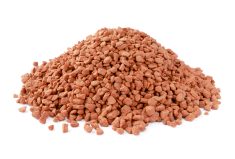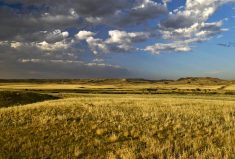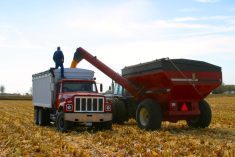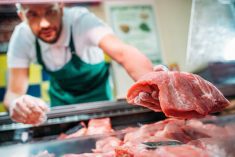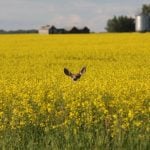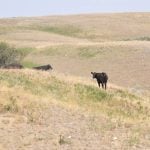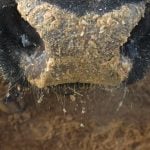Glacier FarmMedia – Cow burps continue to be headline news, with many — from Bill Gates to a Calgary startup — backing seaweed to save the planet from methane-belching cattle.
But despite the hype, slipping a little seaweed into cattle feed is unproven science that needs more study, says one of the leading experts on the issue.
“The jury is still out,” said Karen Beauchemin, who’s been investigating the science of busting cow burps ever since it became an idea. “There needs to be a more comprehensive body of work to really establish what the safety risks are.”
Read Also

100TH ANNIVERSARY: Where does ‘co-op’ fit in the Manitoba Co-operator after a century of farm reporting?
The Manitoba Co-operator is no longer owned by a co-operative, as it was at the start of its run, but Manitoba’s farm paper still reflects the spirit of co-operation that built this province
The ruminant expert, who recently retired from AgCanada’s Lethbridge research station, is particularly concerned about a tropical red algae (Asparagopsis taxiformis) commonly known as red sea plume. Although studies have shown it can reduce methane in the cattle rumen by 90 per cent, there are health concerns about its active component, bromoform.
It is classified by the U.S. Environmental Protection Agency as a probable human carcinogen. Although studies have determined that it doesn’t carry into human-consumed meat or milk when served in small amounts (probably less than one per cent of a cow’s diet), Beauchemin remains skeptical.
“You have to make sure it doesn’t have any carcinogenic effects to the animal but more importantly that there’s no residue in meat and milk,” she said.
Then there’s the fact that artificially growing seaweed comes with its own carbon footprint. Because harvesting seaweed from tropical waters would be staggeringly expensive, a number of startups have opted to grow it in land-based tanks. There’s a greenhouse gas tradeoff in that process, said Beauchemin.
“There are GHGs associated with the growing, the manufacturing, the harvesting and then the extracting and shipping. So you have to offset some of the decrease in methane emission with the increase in carbon dioxide emissions from the process.”
But it’s effective
However, the effectiveness of the seaweed may make the tradeoff worthwhile.
“(Red sea plume) has been shown in several studies — especially in beef animals — to be very, very effective so it could create 15 all the way up to 90 per cent reduction in methane,” she said.
“If we get that kind of methane reduction, even if it means some CO2 increase, it’s still going to mean more reduction in methane than the CO2 produced. But you do have to take that into consideration.”
Another question is whether seaweed grown in tanks would be affordable.
“It’s very expensive to grow artificially,” said Beauchemin.
More research is also needed on the long-term effects on the animals themselves.
“At this point in time there are very few larger-scale studies to say what happens to animal production when you reduce methane emissions by 60, 70, 80 or 90 per cent,” she said. “What happens to animal production? Do they continue to eat normally and produce normally?
“It’s very much still experimental.”
Still, there’s hope beyond red seaweed.
Though retired, Beauchemin still works for Agriculture Canada in an emeritus position, and has launched a research program to look at the efficacy of seaweeds extracted from coastal Canadian waters.
“We don’t (naturally) grow red sea plume but we do have kinds of red and brown and green seaweeds. We’re scanning those different species to see if any of our seaweed has any kind of methane mitigating effect.
“What we’ve found so far is that some of them could have a small effect — we’re looking at maybe 10 or 20 per cent production mitigation. There may be some opportunities for other seaweeds that have bioactive components other than bromoform.”
Seaweed suddenly hot
In any event, the search for seaweed-powered, methane-reducing additives has become big business, so much so that even Bill Gates is in the game, investing millions in the Australian startup Rumin8.
That company recently started safety and efficacy trials of its feed supplements in New Zealand, with one study looking at beef cattle and the other at dairy cows. Rather than harvesting seaweed from oceans, the company reproduces these naturally occurring, anti-methanogenic compounds on land.
Closer to home, Tamara Loiselle is counting on the methane-inhibiting ability of a range of seaweeds to power a supplement she says will reduce cattle greenhouse gases by more than 90 per cent.
“There are multiple bioactive compounds that are naturally occurring in seaweeds that when fed to cattle inhibit methane production,” said Loiselle, a longtime environmental consultant and CEO of a Calgary startup called Synergraze.
And they can’t come to market a moment too soon, she said.
“The amount of carbon dioxide equivalent that comes from cattle is about the same as the entire global transportation sector,” claims Loiselle, whose company motto is “You can eat your beef and help the environment too.”’

In some ways, Alberta is ground zero for methane emissions.
“(There are) 4.9 million head of cattle in Alberta and they produce 8.8 million tonnes of carbon dioxide equivalent from enteric methane,” Loiselle said.
Tonnes of carbon dioxide equivalent isn’t a measure most people can relate to, but cows as climate villains is a recurring theme these days.
The numbers vary but livestock, cattle in particular, are widely viewed as a major source of methane emissions. A 2021 “methane assessment” by the UN Environment Program and an international coalition of government agencies and academic bodies estimated livestock accounts for 32 per cent of global methane emissions — both from manure and “enteric fermentation” (that is, methane produced in the gut and then belched out).
And while methane doesn’t persist as long in the atmosphere as carbon dioxide, it’s more potent, trapping about 25 times more heat, according to the U.S. Environmental Protection Agency.
Attracting investment
That has fuelled criticism of the cattle sector and also boosted interest in additives that reduce methane emissions.
Rumin8 has attracted about $23 million in funding, including money from an investment firm set up by Gates, Amazon founder Jeff Bezos and others to promote innovative environmental tech.
The Australian company, which says its latest round of funding was “oversubscribed,” is in the process of building a pilot production plant and conducting trials Down Under and in the U.S. and Brazil.
Meanwhile, Loiselle’s startup has attracted considerable government money, including $5 million two years ago from Emissions Reduction Alberta, which helped fund a trial on the additive with an Alberta feedlot management company.
Loiselle did not respond to a post-interview request for information on results of the trial. It’s also not clear what type of seaweed Synergraze intends to use, although she recently told a news outlet on Vancouver Island that it will be “seaweeds/algae found naturally in the region.”
The company has partnered with the T’Sou-ke First Nation in southern Vancouver Island on a pilot production facility, producing seaweed and algae in tanks in a former greenhouse.
Last month, the company also received $1.3 million from a federal agency called Sustainable Development Technology Canada “to develop, demonstrate and commercialize” an additive from multiple strains of seaweed.
Don’t forget feed efficiency
As hopeful as Loiselle and other seaweed entrepreneurs may be, regulatory approval in North America may be a long and winding road, at least based on Beauchemin’s experience.
She pointed to 3-nitrooxypropanol (or 3-NOP), a Dutch-created methane-inhibiting compound, as an example of an extensively studied and peer-reviewed additive that is still facing years of regulatory consideration in North America.
She predicts that some seaweed products will face the same fate, particularly if they contain red sea plume.
“In Canada there’s a big long list of all the seaweed families that are approved for feeding. Asparagopsis taxiformis isn’t part of those families, so it would have to go through some kind of special regulatory approval.”
However, the cattle industry needs these solutions now in order to meet growing public demand for greenhouse gas reduction, said Beauchemin.
“I think it’s interesting to say that there’s all these things coming down the pipeline, but can we as an industry afford to wait for those approvals? No we can’t. So we need to look at what we already know will reduce greenhouse gas emissions.”
A simple example, she said, is feed conversion efficiency.
“If you reduce the amount of feed it takes to get a pound of meat or a pound of milk, then you need to grow less feed, the cow eats less and produces less manure so it produces less enteric methane emissions.”
– With staff files





